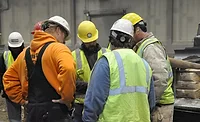How Drillers can Add Adaptive Leadership to their Toolbox
Regardless of What a Team Does, It’s Still Made Up of People

Columnist Jake Fletcher says adaptive leaders find ways to connect with teams, tailoring leadership a bit to each member of the team to bring out their best.
Source: Getty Images
A belated happy New Year to all! I hope this month’s issue of The Driller finds you healthy, safe and taking a coffee break on a jobsite somewhere as you read this. In December’s issue, I painted a picture of what I described as a “blind” leader: essentially, someone who makes things up as they go along. I mentioned the dangers of such a leader: a lack of decisiveness leading to rapidly made, dangerous decisions; and an inability to take input or feedback from others. All of these traits sow frustration and doubt within a team. I also mentioned some do’s and don’ts for approaching a blind leader. Namely, we should not use our subject matter expertise to discredit blind leaders openly or find ways to rid the team of them. Instead, we should offer feedback and attempt to help that person grow and develop into the kind of leader we all strive to become or would trust to lead us in the field.
This month, I would like to discuss adaptive leadership, a growing topic of conversation among friends and colleagues. While scholarly articles and studies discuss this topic in detail, I would like to share my personal perspective on how I came to understand this concept and how it shaped the leader I became. In addition, I would like to share an example of how and why some resist adaptive leadership.
My first experience with adaptive leadership came from my time as the captain of my high school baseball team. I was the catcher, which meant I had to direct operations on the field. My favorite catcher of all time was Jason Varitek, number 33 for the Boston Red Sox. Not only was he a great player behind the dish, but he was also a switch hitter who could hold his own with a piece of lumber in his hands. However, it was not his personal statistics that made me revere him most. Whenever someone would interview his teammates, particularly the pitchers, they would all describe him with the word “trust.” I learned he spent time outside baseball with the pitchers, in particular, so he could gain a deep understanding of them as people. This allowed him to tailor his communications on the field to each man who stepped onto the bump. He became so good at this that pitchers felt uncomfortable if his day off fell on a day they were scheduled to pitch.
I immediately implemented the same strategy on my own team. I found that by eating lunch with a guy or inviting some of them over to hang out in my parent’s basement, I learned who they were and how to get the best out of them to help us win. If a guy was in a jam, I knew how to walk out to the mound and refocus his efforts. Some guys needed the stern get-their-attention speech, while others needed gentler, supportive talk. I even learned which guys had trouble seeing signs (and had to paint my fingernails different colors, so they did not end up throwing a curve when I called for a fastball).
By the time I graduated, my teammates and I had formed a bond and finished second in the state playoffs, and they all expressed how hard it would be to replace me behind the plate. It was my first taste of how to find the best in people and bring it out in support of the common goal: to win. As I made the transition to college where I began my pursuit of the dream to serve my country as an officer in the Air Force, I employed the same tactics any time I was tasked with leadership. I continue to employ adaptive leadership in any leadership capacity to this day. Over the years, troops and colleagues have all said the same thing: “We have never met a leader like you that actually cared about us.” One of my very best friends I served with even said, “I would follow you to hell and back brother.” To me, that is the greatest honor a leader can earn: the complete trust of the people on their team.
Adaptive leadership is a matter of humility. It is the act of “we” not “me.”
Just recently, a friend described an interview they had for a drilling job. This person has a resume that speaks for a leadership style akin to Varitek’s. During the interview, the executives recognized my friend’s expertise and ability to do the job. However, they proceeded to tell my friend that they already had established strategies and culture, and asked whether this person would conform to that culture without question. I told my friend that the company was essentially saying they wanted people to adapt to them, rather than adapt themselves as leaders to their people.
Adaptive leadership is a matter of humility. It is the act of “we” not “me.” It demonstrates the importance of each person, and figures out how to bring out the best from them. In the ROTC, they taught us the phrase “mission first, people always.” I find many leaders have forgotten the second piece of that phrase. You cannot complete a mission, whether winning a baseball game or drilling a water well, without people. A leader people cannot trust cannot expect those people to follow. Of course, there are other ways to earn trust, but for me, adaptiveness is my bread and butter. I challenge you to give it a shot. You may just find it the perfect tool to add to your belt this year. Until next time, Fletch over and out.
Training, Professional Development for Drillers amid Covid-19
Capt. Jake Fletcher appeared on episode 4 of Drilling In-Site, speaking with us about training and professional development during the pandemic. See that episode at www.thedriller.com/articles/91872-training-professional-development-for-drillers-amid-covid-19.
Looking for a reprint of this article?
From high-res PDFs to custom plaques, order your copy today!





